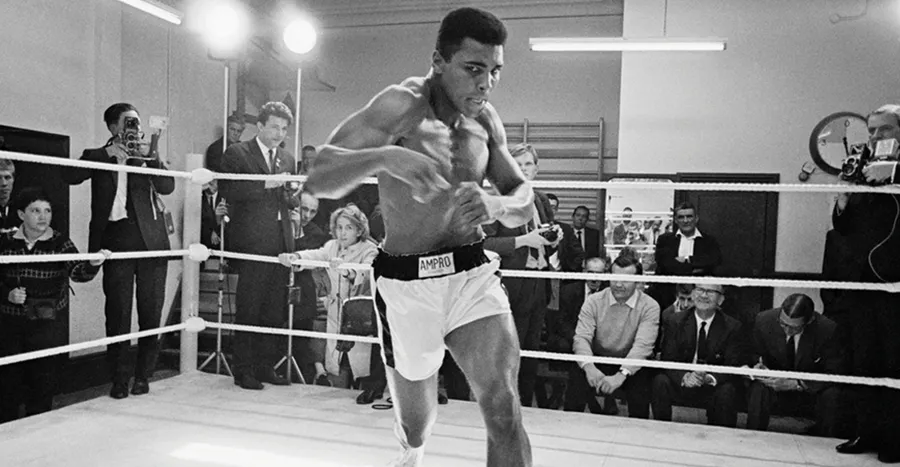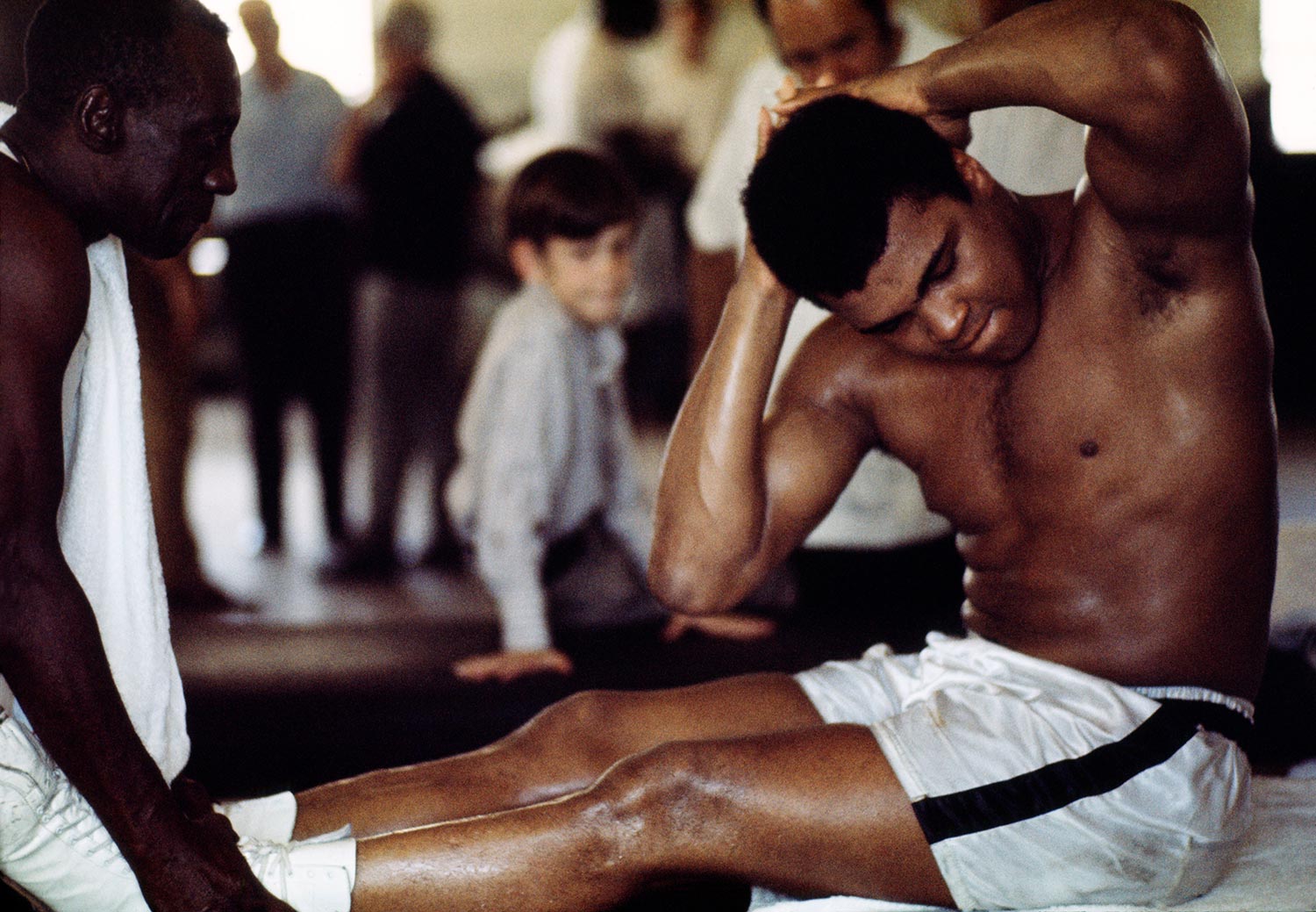Muhammad Ali, considered one of the greatest heavyweight boxers of all time, has a journey that transcends the boundaries of sports, echoing in the realms of civil rights, religion, and humanitarianism. The man fought some of the best boxers of his time including George Foreman, Joe Frazier, Sonny Liston, Ken Norton and many, many more.
However, his fighting wasn’t limited to the ring as he fought against the injustices of his time, even facing serious repercussions for doing so. His indomitable spirit, both inside and outside the ring, continues to inspire generations, making him a true legend in the annals of history.
Today, we take a look at the training regime that led Muhammad Ali to “Float like a butterfly, sting like a bee.”
Daily Routine
“I hated every minute of training, but I said, ‘Don’t quit. Suffer now and live the rest of your life as a champion.’ ” – Muhammad Ali
Muhammad Ali adhered to a disciplined daily routine that reflected his commitment to physical fitness and spiritual well-being. Rising at 4:30 AM, he began his day with a refreshing shower and prayer. A testament to his endurance, Ali embarked on a rigorous 6-mile run in heavy boots at 5:30 AM.
Fueling his body with a nutritious breakfast at 7 AM, consisting of eggs, toast, 100% orange juice, and ample water, he prioritized both energy and health.

The late morning saw Ali taking a restorative nap at 11 AM and heading for training at 12:30 PM. A massage at 4 PM contributed to his recovery and relaxation. Dinner, served at 5 PM, comprised a balanced meal of chicken, steak, green beans, potatoes, and fruit.
Ali embraced the tranquility of an evening walk at 6 PM, followed by another round of shower and prayer at 7 PM. As the day winded down, he allowed himself to unwind with television and relaxation at 8 PM, ultimately retiring for the night at 10 PM.
This well-structured routine not only showcased Ali’s dedication to his craft but also underscored the importance he placed on maintaining a holistic approach to health and spiritual connection.
Mental Conditioning
“I am the greatest! I said that even before I knew I was.” — Muhammad Ali
Muhammad Ali’s training journey commenced not in the gym but within the corridors of his mind. His unwavering self-belief and mental fortitude were the pillars upon which his physical prowess rested. Visualization played a crucial role – he would mentally rehearse his triumphs, creating a mental blueprint for success. This mental conditioning not only boosted his confidence but also set the stage for his iconic in-ring performances.
Float Like a Butterfly, Sting Like a Bee: Agility and Footwork
Ali’s footwork was poetry in motion. To achieve this, he engaged in a variety of drills aimed at enhancing agility, speed, and balance. Jumping rope was a staple, helping him develop the nimbleness that allowed him to glide effortlessly around the ring. Shadowboxing, another key component, allowed him to refine his movements and ensure that every step was a calculated dance with his opponent.

Rumble in the Gym: Sparring Sessions
The heart of Ali’s training was the grueling sparring sessions that simulated the intensity of actual fights. These sessions weren’t just about physical exertion; they were strategic endeavors where he tested and refined his boxing techniques.

Angelo Dundee, Ali’s longtime trainer who’d been with him since his early career, told Sports Illustrated during the training camp, “Ali hasn’t won a round in the gym since I’ve known him. He’s the worst gym fighter in the world. But he always showed me flashes: 10 seconds, 15 seconds.”
His renowned “Ali Shuffle” wasn’t a mere showboat move; it was born in the crucible of these sparring sessions, a deceptive maneuver to confound opponents.
Precision Striking: Hitting the Bags
Ali’s precision in the ring was a result of countless hours spent hitting various bags – heavy bags, speed bags, and double-end bags. Each served a specific purpose in his training routine.

Heavy bags built power and endurance, speed bags refined hand-eye coordination, and double-end bags honed accuracy and timing. The rhythmic sound of his punches hitting the bags was a symphony of calculated force.
The Core of the Matter: Strength Training
Ali had an old school approach to his training often incorporating movements like chopping wood and hitting tyres with sledgehammers.
Core strength was a focal point, crucial for stability and generating power in his punches. He didn’t focus on lifting weights and instead prioritized bodyweight exercises, medicine ball workouts, and resistance training were integrated into his routine. The emphasis was on functional strength that translated directly into the demands of the ring.

His trainer Angelo Dundee revealed that Ali never used weight training in his routine. “My belief is that a fighter’s muscles can’t bulk up,” the legendary trainer said. “There can’t be any restrictions to their punches. I ain’t got nothing against weights. A lot of guys use weights, and they do well with them, but he didn’t.”
The Rope-A-Dope: Endurance and Stamina
The iconic “Rope-A-Dope” strategy employed by Ali against George Foreman in the “Rumble in the Jungle” was a testament to his extraordinary endurance. Ali’s training reflected this focus on stamina, with long-distance running, cycling, and high-intensity interval training being key components. His ability to outlast opponents, both mentally and physically, became a hallmark of his fighting style.

Defensive Mastery: Head Movement and Ducking Drills
Ali’s defensive prowess was as remarkable as his offensive skills. Head movement drills, where he bobbed and weaved to avoid punches, were integral. Ducking drills, often performed with a partner throwing rapid-fire punches, enhanced his ability to slip away from oncoming attacks. This defensive finesse was showcased in his “rope-a-dope” strategy and the famous “Ali shuffle.”

Rest and Recovery

Ali understood the importance of rest and recovery in the training equation. Quality sleep, proper nutrition, and strategic rest days were as crucial as the intense training sessions. His body needed time to repair and rejuvenate, ensuring that he stepped into the ring at his peak.
Adaptability and Innovation: The Ali Approach

What set Ali apart wasn’t just the intensity of his training but his adaptability and innovative approach. He wasn’t afraid to experiment with unconventional methods, constantly evolving to stay ahead of the competition. Whether it was adopting new stances or incorporating psychological tactics into his training, Ali’s approach was as dynamic as his boxing style.
Legacy Beyond the Ring: Influence on Modern Training

Muhammad Ali’s training legacy extends beyond his illustrious career. His methods continue to influence modern training philosophies. The integration of mental conditioning, focus on agility, and the emphasis on functional strength are principles embraced by athletes across various disciplines.